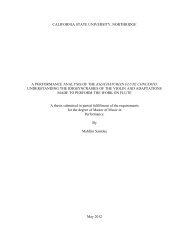2644 - CSUN ScholarWorks - California State University, Northridge
2644 - CSUN ScholarWorks - California State University, Northridge
2644 - CSUN ScholarWorks - California State University, Northridge
Create successful ePaper yourself
Turn your PDF publications into a flip-book with our unique Google optimized e-Paper software.
journal of Student Research Abstracts · 19<br />
cereus only grew on live E. coli or on dead bacteria because it spread outside of the original streak and into<br />
another unstreaked area in both samples. Therefore, I concluded that interspecies conjugation did indeed occur.<br />
2677<br />
EFFECT OF YEAST ON THE ROTTING OF APPLES.<br />
Wayne To and Steven DeGusta, (teacher). John F. Kennedy High School, 6715 Gloria Drive, Sacramento,<br />
CA 95831.<br />
Rotting is the leading cause of fruit industry losses. A possible way help fight rotting is the addition of a<br />
naturally-occurring organism such as yeast, which can thrive inside fruit and prevent any pathogens from<br />
invading and destroying the fruit. To test the effects of yeast on the rotting of apples, a cube was cut out of each<br />
apple (wound) and purposely infected with fungi to induce rotting. One experiment involved the addition of<br />
baker's yeast (Saccharomyres cerevisae) to ten test apples. Red yeast (Rhodotorula rubra), a relative to<br />
Rhodotorula glutinis, a successful biocontrol for pears, was also added to eight apples and were considered the<br />
other test group. Both controls groups were left out to rot without the addition of the yeast.<br />
The results show that those apples with red yeast applied had only a small effect on the decay of the apple<br />
when compared with their control counterparts (t > 0.1). The baker's yeast, on the other hand, had no effect on<br />
the rotting of the apples. The red yeast did show that it could slow down the rotting process. A possible reason<br />
for the yeast having little effect is that it was outcompeted by the fungi since the fungi came straight from<br />
growth on previously rotted apples. Also, the in another test, it was shown that on five plates of potato dextrose<br />
agar, fungi from rotted apples grows in a way that will take up more space than red yeast. This means that the<br />
fungi will eventually outcompete the yeast for available living space. In order for an effective biocontrol to be<br />
found, a strain of yeast that can grow well on apples is needed to test its effectiveness against rotting.<br />
2278<br />
SURVIVAL OF THE FITTEST.<br />
Ronald L. Lew and Steve DeGusta (teacher). John F. Kennedy High School, 6715 Gloria Drive,<br />
Sacramento, CA 95831.<br />
The purpose of this experiment was to test if deformed wings affect the selection of a mate between flies. To<br />
test this, the male homozygous wild flies, male homozygous vestigial (genetically wingless) flies, and the female<br />
heterozygous wild flies were placed into one culture. The offspring would determine which types of flies were<br />
chosen as a mate. Another combination that I used was male homozygous wild flies, male homozygous vestigial<br />
flies, and female homozygous vestigial flies were placed into a culture. In order for my experiment to work,<br />
the cultures must be prepared properly. I mixed the Drosophila medium with water and placed it into a culture. I<br />
used approximately 5 ml of water and 5 ml of medium. This medium acts like a spoiled fruit in which the flies<br />
lay their eggs, which in tum, turns into adult flies. The flies had to be etherized before transferring them into a<br />
culture. If not etherized, the wild flies would simply fly away. There were a total of 22 cultures. 11 cultures had<br />
2 male homozygous wild flies, 2 male homozygous vestigial flies, and 2 female heterozygous wild flies in it. The<br />
remaining 11 had 2 male homozygous wild flies, 2 male homozygous vestigial flies, and 2 female homozygous<br />
vestigial flies in it. There were 10 cultures that the offspring were only wild flies. 3 of the 10 had 2 male homozygous<br />
wild flies, 2 male homozygous vestigial flies, and 2 female heterozygous wild flies initially. The remaining<br />
7 had 2 male homozygous wild flies, 2 male homozygous vestigial flies, and 2 female homozygous vestigial flies<br />
initially. The other 11 cultures had a mixture of wild and vestigial flies. I look at the phenotype of the flies when<br />
determining whether the flies are wild or vestigial. I cannot conclude from this experiment that the wild flies have<br />
an advantage over the vestigial flies when the female chooses a mate because only half of the vials have only wild<br />
flies for offspring. If this lab were to be done over again, I would have 1 female fly in each culture. This would<br />
make it easier when determining which type of fly mated with the female flies. If a male homozygous vestigial<br />
fly mate with a female fly and a male homozygous wild fly mate with a female fly in the same culture, then it<br />
would be difficult to determine which flies were the parent flies. (p













